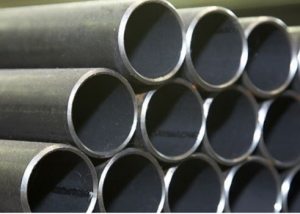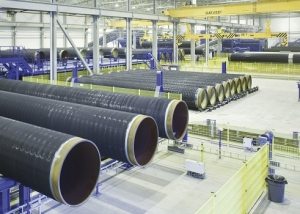Steel pipes are considered one of the most commonly used products in the creation of pipelines for transporting water and gas. Steel, despite the large number of types of polymer on the market, does not give up its positions and is still considered to be a strong and durable material. The choice steel gas pipes will depend on the type of communication: for different purposes, different sizes and diameters of products are needed.
Content
Classification of steel VGP pipes: dimensions and characteristics
The main technical document that governs the assortment and quality requirements of VGP pipes is now existing GOST number 3262-75. The presented standard dictates the standards for such types of steel products: welded galvanized and non-galvanized steel products, pipes with cylindrical thread applied by cutting or rolling, as well as pipes without thread. Acceptable use of products according to the current GOST will be in the field of gas and water supply systems, heating communications, as well as some parts of the above systems.
According to the principle of production, processing and the type of raw materials used, VGP pipes are distinguished as follows:
- water-galvanized pipe;
- VGP pipes welded not galvanized (from black steel).
Also, the specified regulatory document includes the classification of products such as galvanized or non-galvanized steel water and gas pipes according to the criterion of the degree of accuracy of manufacture. Accuracy groups are as follows:
- VGP welded pipes made of ordinary precision material. The production of these products does not imply standardization of the chemical composition of steel and its mechanical properties. Widely used steel pipelines of usual accuracy in everyday life: carrying out plumbing and heating systems, laying gas pipelines.
- VGP welded pipes of high precision material. They are made only of galvanized steel (galvanizing can be applied in various ways, including on the finished product). High precision parts are needed to create large-scale pipelines.
Straight sections of any water and gas pipes go on sale with a length of 4 meters to 12 meters. They can be delivered both unmeasured lengths and measured ones, sometimes - multiple measured ones. The latter option implies an allowance for each cut of approximately 5 mm.
VGP steel pipe: classification by diameter, calculation of the mass of a meter of the product
The main parameter responsible for the classification of VGP products is the diameter of the pipes. This indicator is designated as DU (conditional diameter, in some documents - conditional passage), it is also the main factor for determining the compatibility of steel pipes and connecting elements to them. The minimum conditional pass according to GOST - ДУ 6, the maximum - ДУ 150.
The inner diameter in the region of the thread produced by knurling can be reduced to 10% with respect to the rest of the length of the product.
Important! The remote control and the actual internal diameter of the pipe are not equal, and the conditional passage is usually indicated in the documentation without specifying units of measurement."Pipe DN 25" is the correct name for the product, and the name "DN 25 mm" will be incorrect.
More correct would be the ratio of the remote control with dimensions in inches (1 English inch is 2.54 centimeters). The dimensions of VGP pipes in inches greatly simplify the process of selecting fittings, plugs and other components for pipelines, as these products are also usually marked in an inch measurement system. The table of correspondence of the designations of the diameter of the VGP pipes in the inch system is presented below.
Table 1
| Inches | Conditional pass |
| ¼ - a quarter of an inch | DN 8 |
| ½ - "half an inch" | DN 15 |
| ¾ | DN 20 |
| 1 - inch | DN 25 |
| 1.25 - inch and a quarter | DN 32 |
| 1,5 - "one and a half inch" | DN 40 |
| 2 - two inch | DN 50 |
| 2,5 | DN 65 |
| 4 | DN 100 |
The main criterion for calculating the cost of 1 meter of VGP pipe is its weight, and not the length, as for other linear products. The weight of 1 meter of galvanized steel VGP pipe will be 3% higher than the same number of non-galvanized pipes. When calculating the weight of the VGP pipe, a standard indicator of the density of steel is taken, namely 7.85 gram / cm³. The weight of the water and gas pipe is determined by the norm and is a constant value.
The table shows the mass of 1 meter of the most frequently purchased steel welded water and gas pipes.
table 2
| DU (conditional pass) | Weight 1 meter light tubes, kg | Weight 1 meter ordinary pipes, kg | Weight 1 meter of reinforced pipes, kg |
| DN 10 | 0,75 | 0,8 | 0,98 |
| DN 15 | 1,16 | 1,29 | 1,43 |
| DN 20 | 1,5 | 1,67 | 1,86 |
| DN 25 | 2,12 | 2,4 | 2,92 |
| DN 32 | 2,73 | 3,1 | 3,78 |
| DN 40 | 3,33 | 3,85 | 4,35 |
| DN 50 | 4,33 | 4,89 | 6,16 |
| DN 65 | 5,71 | 7,05 | 7,89 |
In addition to the general data on the dimensions for the water and gas pipe, the standard defines the maximum allowable maximum deviations given in table No. 3.
Table 3
| Sizes: diameter with conditional pass | Deviations for VGP pipes accuracy: conventional | Deviations for VGP pipes accuracy: increased |
| 10 to 40 (in mm) | < 0,4
>0,5 |
< 0,4
>0,4 |
| From 40 (percent) | <0,8%
>1,1% |
<0,8%
>0,8% |
| By wall thickness (in%) | >15% | >10% |
Certificate of conformity for a steel water and gas pipe
Upon completion of the production cycle, all products may be subject to certification. According to the law, compulsory certification is required only for pipes intended for laying global oil and gas pipelines, as well as for polyethylene pressure products. The certificate of conformity is presented as an official document at the highest level confirming the safety of the delivered products. Pipelines that have not passed mandatory certification cannot be put on mass sale.

To confirm the quality of the pipes with an appropriate document, they are subjected to rigorous inspection.
If we are talking about a certificate of conformity for steel gas pipes, the manufacturer has the right to undergo voluntary certification to confirm the quality of his products. The certificate of conformity indicates compliance with the provisions of the state standard under the number 3262-75.
The certification confirmation scheme involves a series of laboratory tests. The quality of the weld is tested (non-destructive method is used). A certain part of the pipes from the party passes hydraulic tests under a stable pressure of 2.4 MPa. The certificate of conformity indicates the detailed chemical composition of the steel involved in the manufacture of products.
The certificate of conformity contains information on whether the right of shipment for export was issued to the product. In the event that the manufacturer’s products (in this case, a steel water and gas pipe) are different from those supplied by GOST, i.e. the technological process of production is amended according to the personal development of the enterprise, technical conditions are entered into the certificate.
Correctly selected steel pipes for all regulatory technical indicators have the highest performance characteristics. They can retain their qualities for at least several decades under conditions in which the use of polymer pipes is unacceptable.








